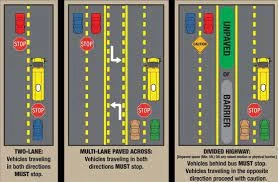School buses are a vital part of the road safety system, as they are designed to keep children safe on their way to or from school.
This practice is important not just for legal reasons but also to protect the safety of young children, who are the most vulnerable road users.
School buses signs
The flashing of red lights on a school bus signals the arrival or departure of children. All drivers, regardless of the direction they are traveling, must stop at this point. The purpose of this law is to establish a zone that allows children to safely cross the street without being in danger from oncoming traffic. This rule is strictly enforced, and if it’s not followed, there can be severe consequences. It emphasizes the importance of protecting schoolchildren during their daily commute.
Stopping for school buses stems from the fact that children may lack the experience or knowledge to safely navigate the traffic. The flashing red light of the school bus signals the arrival or departure of children. The area surrounding the bus is designated as a safety zone and drivers must stop their cars. This preventative measure helps to avoid accidents, and allows children to cross the street without being afraid of traffic. Stopping for school buses is a collective responsibility that stems from the shared desire to ensure pedestrian safety.
Violations of the law can result in severe penalties. The penalties for failing to stop at a school bus that has stopped can be fines, driving record points, or, in some cases, a license suspension. The consequences aren’t just punitive, but also serve to deter future offenses. The authorities want to encourage drivers to put safety first when they share the road with school busses by enforcing strict consequences for failure to comply. Stopping for school buses is a legal requirement that can be used to promote a responsible driving culture, particularly in places where students frequently commute.

Stopping for school buses is more than just a legal requirement. It’s also a commitment to the safety of communities and future generations. By adhering to this practice, motorists contribute to creating a safe environment for students to get to and from the school. Stopping for school buses reflects a shared understanding of the importance of safety over convenience. The commitment goes beyond legal requirements, reflecting a common ethos of valuing the safety and wellbeing of young members of the community.
The importance of stopping at school buses is reinforced by education. The dissemination of information on this important safety measure is aided by driver education programs, awareness campaigns and school-based initiatives. The drivers need to know the law, potential penalties for non-compliance and why stopping at school buses is a good idea. Education empowers drivers by fostering an awareness of the consequences of their decisions, creating a safe environment for children on the roads and instilling a culture of vigilance.
Conclusion
Stopping for school buses, in conclusion, is more than a mere legal requirement. It is an important element of road safety that is deeply rooted within a desire to protect the lives of children. The practice allows children to board and leave school buses without being in danger of collisions with oncoming traffic. This safety measure is enforced by the legal framework and penalties for not complying. Stopping for school buses is more than just a legal requirement. It reflects the community’s commitment to fostering responsible driving and prioritizing children. Stopping for school buses is a way to demonstrate social responsibility, as well as a commitment to road safety.The purpose of this law is to establish a zone that allows children to safely cross the street without being in danger from oncoming traffic.
